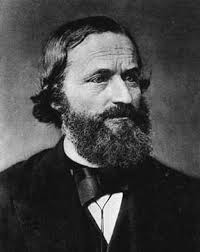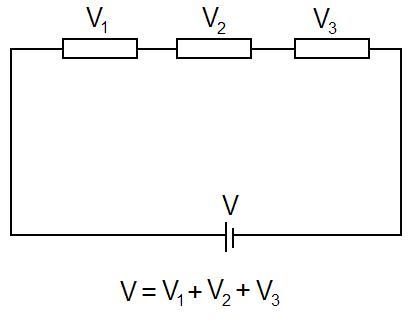Loop Rule: Difference between revisions
| Line 31: | Line 31: | ||
[[File:MediumExampleLoopRule.jpg]] | [[File:MediumExampleLoopRule.jpg]] | ||
The circuit shown above consists of a single battery, whose emf is 1.3 V, and three wires made of the same material, but having different cross-sectional areas. Each thick wire has cross-sectional area 1.5e-6 m2, and is 19 cm long. The thin wire has cross-sectional area 6.3e-8 m2, and is 7.5 cm long. In this metal, the electron mobility is 6e-4 (m/s)/(V/m), and there are 6e+28 mobile electrons/m3. | The circuit shown above consists of a single battery, whose emf is 1.3 V, and three wires made of the same material, but having different cross-sectional areas. Each thick wire has cross-sectional area 1.5e-6 m2, and is 19 cm long. The thin wire has cross-sectional area 6.3e-8 m2, and is 7.5 cm long. In this metal, the electron mobility is 6e-4 (m/s)/(V/m), and there are 6e+28 mobile electrons/m3. | ||
Revision as of 16:16, 2 December 2015
The Loop Rule is a fundamental principle of electric circuits that claims that in any round trip path in a circuit, Electric Potential equals zero.
Loop Rule
The loop rule simply states that in any round trip path in a circuit, Electric Potential equals zero. This principle deals with the conservation of energy within a circuit. Loop Rule and Node Rule are the two fundamental principle of electric circuits and are used to determine the behaviors of electric circuits. This principle is often used to solve for resistance of the light bulbs or other types of resistors or the current passing through these resistors.
A Mathematical Model
A mathematical representation is: [math]\displaystyle{ \Delta {V}_{1} + \Delta {V}_{2} + \space.... = 0 }[/math]
This can also be represented in a circuit as [math]\displaystyle{ emf = \Delta {V}_{1} + \Delta {V}_{2} + \space..... }[/math]
A Visual Model
The total voltage in the circuit is equal to all the individual voltages in the circuit added together.
Another way to think about it is [math]\displaystyle{ \Delta {V} - (\Delta {V}_{1} + \Delta {V}_{2} + \Delta {V}_{3})= 0 }[/math]
Examples
Be sure to show all steps in your solution and include diagrams whenever possible
Simple
Middling
The circuit shown above consists of a single battery, whose emf is 1.3 V, and three wires made of the same material, but having different cross-sectional areas. Each thick wire has cross-sectional area 1.5e-6 m2, and is 19 cm long. The thin wire has cross-sectional area 6.3e-8 m2, and is 7.5 cm long. In this metal, the electron mobility is 6e-4 (m/s)/(V/m), and there are 6e+28 mobile electrons/m3.
The symbol EF represents the magnitude of the electric field at location F, and the symbol ED represents the magnitude of the electric field at location D. Which of the following equations is a correct energy conservation (loop) equation for this circuit, following a path that starts at the positive end of the battery and goes clockwise?
Difficult
History
The Loop Rule is formally known as the Kirchhoff Circuit Law, named after Gustav Kirchhoff discovered and defined this fundamental concept of electric circuits. He discovered this during his time as a student at Albertus University of Königsberg in 1845. Kirchoff went on to explore the topics of spectroscopy and black body radiation after his graduation from Albertus. For more in depth information about Gustav Kirchhoff, visit the full wiki page on him: Gustav Kirchhoff

Connectedness
- How is this topic connected to something that you are interested in?
- How is it connected to your major?
- Is there an interesting industrial application?
Since the Loop Rule is a fundamental principle of circuits,
See also
Other Circuit Concepts you can check out :
More Information and External links
Kirchoff's Circuit Laws - Wikipedia
Loop Rule - Boundless.com Textbook
Loop Rule - Doc Physics Video Lecture
References
- https://en.wikipedia.org/wiki/Kirchhoff%27s_circuit_laws#Kirchhoff.27s_voltage_law
- Chabay, Ruth W. Matter and Interactions: Electric and Magnetic Interactions. John Wiley, 2015. Print.
- http://www.ux1.eiu.edu/~cfadd/1360/28DC/Loop.html
Claimed by Bmock7

